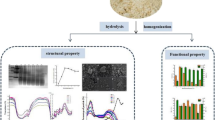Abstract
Fibers were produced from soy protein isolate by both wet-spinning and extrusion. In the wet-spinning process, aged, alkaline protein solution was forced through a spinnerette into an acid coagulating bath. In the extrusion process, a twinscrew extruder forced a protein isolate-water mixture through a die. The physical properties of the fibers were measured at various water activities. The fibers produced by both methods were brittle and lacked tensile strength (tenacity). The addition of glycerol reduced brittleness in extruded fibers. Zinc and calcium ions decreased the brittleness of wet-spun fibers. The tenacity of soy fibers was significantly improved by post-spinning treatments, including acetic anhydride, acetaldehyde, glyoxal, glutaraldehyde, a combination of glutaraldehyde and acetic anhydride, and stretching. The best extruded fibers were produced with a mixture of 45% soy protein, 15% glycerol, and 40% water, finished with a combination of glutaraldehyde and acetic anhydride and then stretched to 150% their original lengths. The best wet-spun fibers were produced with a 19.61% soy protein suspension at pH 12.1; coagulated in a 4% hydrochloric acid solution that contained 3.3% sodium chloride, 3.3% zinc chloride, and 3.3% calcium chloride; and followed by treatment with 25% glutaraldehyde and stretching to 170% their original lengths.
Similar content being viewed by others
References
Kajita, T., and R. Inoue, U.S. Patent 2,192,194 (1940).
Kajita, T., and R. Inoue, U.S. Patent 2,198,538 (1940).
Kajita, T., and R. Inoue, U.S. Patent 2,237,832 (1941).
Boyer, R.A.,Ind. Eng. Chem. 32:1549 (1940).
Bergen, W.,Rayon Textile Monthly 25:57 (1944).
Huppert, O., U.S. Patent 2,298,127 (1942).
Huppert, O., U.S. Patent 2,309,113 (1943).
Huppert, O., U.S. Patent 2,364,035 (1944).
Huppert, O., U.S. Patent 2,377,885 (1945).
Boyer, R.A., W.T. Atkinson, and C.F. Robinette, U.S. Patent 2,377,854 (1945).
Boyer, R.A., J. Crupi, and W.T. Atkinson, U.S. Patent 2,377,853 (1945).
Boyer, R.A.,Soybean Dig., June12 (1947).
Lubuza, T.P., K. Acott, S.R. Tatini, R.Y. Lee, J. Fink, and W. McCall,J. Food Sci. 41:910 (1976).
Annual Book of ASTM Standards, American Society for Testing and Materials, Philadelphia, 1991, Method D2101-91.
SAS User’s Guide, Basic, SAS Institute, Inc., Cary, 1992.
Huang, H.C., The Production of Textile Fibers from Soy Proteins, Ph.D. Thesis, Iowa State University, Ames, 1994.
Dean, J.A.,Lange’s Handbook of Chemistry, 12th edn., McGraw-Hill Book Co., New York, 1979.
Hartsuch, B.E.Introduction to Textile Chemistry, John Wiley & Sons, New York, 1950, pp. 360–373.
Ziegler, K., West German Patent 165–177 (1975).
Joseph, M.L.,Essentials of Textiles, Holt, Reinhart and Winston, Inc., New York, 1988, p. 17.
Author information
Authors and Affiliations
About this article
Cite this article
Huang, H.C., Hammond, E.G., Reitmeier, C.A. et al. Properties of fibers produced from soy protein isolate by extrusion and wet-spinning. J Am Oil Chem Soc 72, 1453–1460 (1995). https://doi.org/10.1007/BF02577837
Received:
Accepted:
Issue Date:
DOI: https://doi.org/10.1007/BF02577837




